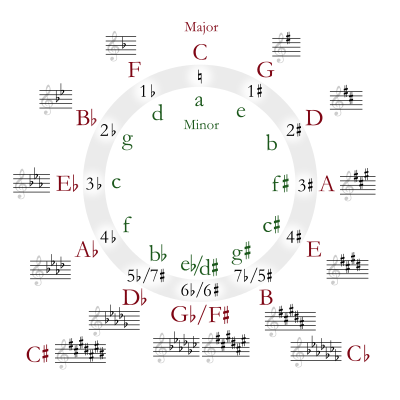E minor
 | |
| Relative key | G major |
|---|---|
| Parallel key | E major |
| Dominant key | B minor |
| Subdominant | A minor |
| Component pitches | |
| E, F♯, G, A, B, C, D, E | |
E natural minor scale ascending and descending.  Play
Play
E harmonic minor scale ascending and descending.  Play
Play
E melodic minor scale ascending and descending.  Play
Play
E minor is a minor scale consisting of the pitches E, F♯, G, A, B, C, and D. Its key signature has one sharp. The E harmonic minor raises the note D to D♯.
Its relative major is G major, and its parallel major is E major.
Much of the classical guitar repertoire is in E minor, as this is a very natural key for the instrument. In standard tuning (E A D G B E), four of the instrument's six open (unfretted) strings are part of the tonic chord. The key of E minor is also popular in heavy metal music, as its tonic is the lowest note on a standard-tuned guitar.
Notable classical compositions in this key
- String quartet Op. 59/2 – Ludwig van Beethoven
- Piano sonata Op. 90 – Ludwig van Beethoven
- Symphony No. 4 – Johannes Brahms
- Cello Sonata No. 1 – Johannes Brahms
- Nocturne in E minor – Frédéric Chopin
- Piano Concerto No. 1 – Frédéric Chopin
- Prelude in E minor – Frédéric Chopin
- Waltz in E minor – Frédéric Chopin
- Symphony No. 9 "From the New World" – Antonín Dvořák
- Slavonic Dance No. 2, Op. 72 – Antonín Dvořák
- Cello Concerto – Edward Elgar
- Sea Pictures – Edward Elgar
- String Quartet – Edward Elgar
- Violin Sonata – Edward Elgar
- Piano Sonata – Edvard Grieg
- Symphony No. 44 "Trauer" – Joseph Haydn
- Cello Concerto No. 2 - Victor Herbert
- Praeludium and Allegro – Fritz Kreisler
- Violin Concerto in E minor – Felix Mendelssohn
- Violin Sonata No. 21 – Wolfgang Amadeus Mozart
- Caprice No. 3 – Niccolò Paganini
- Caprice No. 15 – Niccolò Paganini
- Montagues and Capulets – Sergei Prokofiev
- Symphony No. 2 – Sergei Rachmaninoff
- Vocalise, Op. 34, No. 14 – Sergei Rachmaninoff
- Scheherazade – Nikolai Rimsky-Korsakov
- Piano Trio No. 2 – Dmitri Shostakovich
- Symphony No. 10 – Dmitri Shostakovich
- Symphony No. 1 – Jean Sibelius
- Symphony No. 5 – Pyotr Ilyich Tchaikovsky
- Symphony No. 6 – Ralph Vaughan Williams
- The Lark Ascending – Ralph Vaughan Williams
- Concerto for Bassoon, Strings, and continuo, RV 484 – Antonio Vivaldi
See also
- Key (music)
- Major and minor
- Chord (music)
- Chord names and symbols (popular music)
- List of symphonies in E minor
External links
 Media related to E minor at Wikimedia Commons
Media related to E minor at Wikimedia Commons
| Diatonic scales and keys | |||||||||||||||||||||||||||||||||||||||||||||||||||||||
|---|---|---|---|---|---|---|---|---|---|---|---|---|---|---|---|---|---|---|---|---|---|---|---|---|---|---|---|---|---|---|---|---|---|---|---|---|---|---|---|---|---|---|---|---|---|---|---|---|---|---|---|---|---|---|---|
 |
| ||||||||||||||||||||||||||||||||||||||||||||||||||||||
| The table indicates the number of sharps or flats in each scale. Minor scales are written in lower case. | |||||||||||||||||||||||||||||||||||||||||||||||||||||||
This article is issued from Wikipedia - version of the 11/28/2016. The text is available under the Creative Commons Attribution/Share Alike but additional terms may apply for the media files.